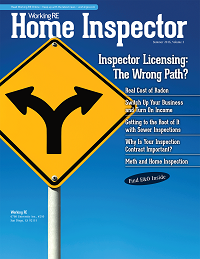 |
> E&O Insurance: OREP Invites You to Compare Coverage & Rates (get ready to smile) > InspectorAdvisor: Get Your Tough Inspection Questions Answered by a Pro |
Editor’s Note: The following is taken from the current print edition of Working RE magazine, the largest print publication for inspectors nationwide. OREP insureds enjoy a free subscription to WRE (get an E&O/GL quote from OREP in 30 seconds).
Getting to the Root of It with Sewer Inspections
By Peter Hopkins, Co-Founder, United Infrared
Having been a home inspector for 20 years, one thing I can tell you is that I have ridden the rollercoaster and have learned a lot along the way. My first decade in the home inspection business enjoyed constant growth, allowed my company to expand to four inspectors, and rewarded me with a handsome income.
By 2005, however, the economy changed and the real estate market started to flatten out. That forced me to rethink my business and how I approached it in the first place. What I learned was that I chose a business that I didn’t have complete control over. In other words, if the banks would not lend money to people to buy houses, they obviously didn’t need home inspections. Have you ever heard the term, “save your pennies for a rainy day”? This was something I didn’t comprehend in the good years. I was buying new trucks, RVs and even a bigger house. The problem was that my income didn’t continue to sustain those purchases and I needed to make drastic changes. I decided to expand my business vision with services that were not tied as directly to the economy.
Expanding the Vision
During the late ’90s one of my inspectors advised me that he needed to make more money, so he had taken a night shift working as a thermographer. I became completely enamored. I actually wrote a business plan on infrared almost immediately. Unfortunately, I lacked the time to expand and implement it due to my busy inspection schedule and put it on the back burner. Although years went by before I pulled the trigger, I finally made the investment in thermography in 2005. I recognized the coming trend, which later led to the creation of my company United Infrared, Inc. in 2008. It worked out great but would I have been better off had I started when I first wrote the business plan? That is a great question I often ask myself. One thing that I can tell you is that over a decade after the infrared technology revolution was foretold, the future is now.
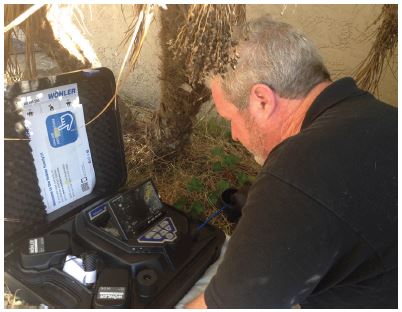
Infrared has become the latest trending tool with home inspectors. Unfortunately, many inspectors claim there is little or no money in adding infrared as an add-on to their inspection. Adding thermography appears to have been a marketing decision vs. a huge money maker for many. Thermal imaging as a stand-alone business, however, is a whole different animal. It has made me a lot of money but that is for another story. Here is where we start to dive into sewer inspections and why you seriously need consider them for the future, even if you are riding that rollercoaster up right now!
Sewer Inspections
Like most inspectors, I am always looking for an edge on what can differentiate me from my competitors; it boils down to the variety of services that I offer. If you have ever invested, your financial planner has likely told you to diversify your investments. Adding new services like thermography, radon testing, energy testing, mold testing and sewer inspections can help you diversify your services so that if a slow economy occurs again, you will be better positioned for it. “Work smarter, not harder” can be applied here because during a down economy you will likely do fewer inspections, but with added services, you can make more money per inspection. Most inspectors appreciate this idea! We will get into the money part later but let’s dive into sewer inspections a little deeper and why you should consider them. Since the home inspector is proven to be the most trusted person in an entire real estate transaction, homebuyers will take the inspector’s advice seriously without hesitation.
People buy out of fear. Fear that something serious could go wrong haunts us. This is a very simple sales principle. The buyer knows if anything comes up, it is a negotiable item now vs. an expense for them later if not addressed. They know that if there are no problems with the sewer system, they will sleep better at night.
A couple of things to know about the sewer system will help you decide if this business is for you. The sewer lateral or line from house to the city connection or septic is typically the responsibility of the homeowner (See Figure 1).
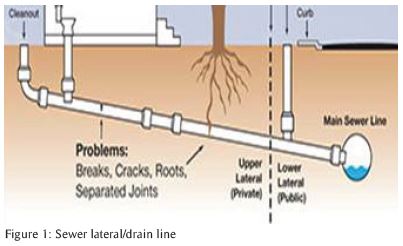
This means even if the sewer line is under the street and damage occurs, repairs are the responsibility of the homeowner. Trust me, this can get very expensive when it comes to dealing with public works and digging up a street. According to costhelper.com, the average cost of a sewer line replacement is $7,493 with costs ranging from $50–$250 per lineal foot. I have seen sewer line repairs cost over $30,000. Unfortunately, the scope of the home inspection is testing functional drainage at fixtures. This rarely will identify a sewer problem downstream but rather just find some hair clog at the trap. Additionally, sellers have a hard time disclosing unknown problems which makes this whole mystery more appealing for a buyer when offered vision to the “unknown.”
(story continues below)
(story continues)
In my business, I use a simple formula for determining if a sewer scan is appropriate: if the home is 20 years or older, if it has a nice newer cleanout (sign of past problems), if it has trees between the house and city sewer or if there is disclosure of any past repairs, it is a likely prospect. Provided there is an accessible cleanout (we do not pull toilets) and the above conditions exist, I offer the service to my client during the home inspection. The large majority of my clients will accept the service and at a cost of $175, I have increased my home inspection revenue by 35%. You obviously can charge what you like for your business and depending on your area it may be more or less than the numbers above. Overall, I find the sewer scan to be a win-win proposition as I am helping my clients and increasing my revenue. The sewer scan adds about 15 minutes and reaps a good return.
Equipment
The equipment necessary to complete a scan is a sewer camera. You have several to choose from including features and price. One thing I would suggest is not to base your decision on price, which is what we tell all our clients, right? There are low-cost camera systems out there but take my advice, you can make good money from this and can afford a high quality camera. You will find that these cameras range from $1,000 to $12,000 for a residential-type camera. It all is about the features that you want in a camera. The low cost models will typically have bulkier or larger equipment and lack necessary features. The more expensive models will have a more professional look and typically are packed with the features you may want and need. For me, I chose a mid- to higher-priced unit with a pan-and-tilt camera that was compact and offered a very professional appearance (Figure 2).
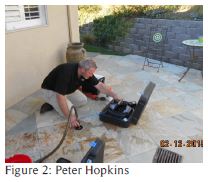
The pan-and-tilt camera head gives me additional uses like chimney or duct inspections, and diversification is everything right? For those who question the investment, I will give you a simple calculation. The monthly payment on financing a $7,000 piece of equipment, with good credit, works out to be about one sewer scan per month. If you can do that, the rest will be all profit!
(story continues below)
(story continues)
Yuck Factor
We find all kinds of things in sewer lines but to dispel a few things: no, you are not running your camera through poop like you might think. And no, the camera is not coming back out with a bunch of feces on it. Yes, there is debris and a cleaning protocol but when you are prepared (the best rubber gloves you can buy) and have a good procedure, you are still good to shake the client’s hand at the end of inspection. The most common things we find are roots, bellies, offsets, damaged lines and debris…oh yeah, a few critters too… This photo shows a big enough hole for a full-flowing tub to drain but the drain line is over 80% clogged (Figure 3).
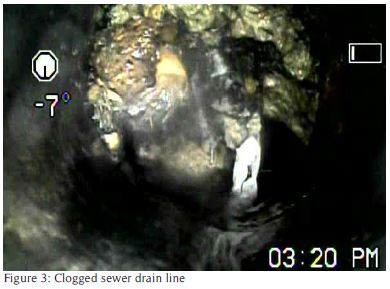
The agent sent me the follow-up photo and the copy of invoice which shows the seller paid $2,500 for the cleanout (Figure 4).
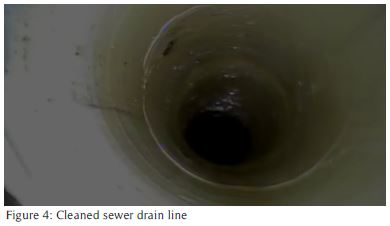
While scanning the drain line, we will often find conditions like bellys (low points) (Figure 5), scale build up (Figure 6), offsets (Figure 7), roots (Figure 8) and of course a few other interesting things along the way. If you would like to see some additional photos or videos, you can visit Sewerscan.com for more examples in the project gallery.
Of course adding this service can obviously increase risk on your inspection and you should examine your insurance coverage as well as any legal ramifications of adding this service. (Many E&O providers, such as OREP, can add “septic” coverage for a small additional premium.) However for my business, I view it as being a risk-reward condition.
As inspectors, we take risks each day in doing home inspections and this is no different. However, the pay is much higher. Provided you do your job and report the conditions, I believe the risk is minimal as the video and photos will speak for themselves. I can’t emphasize training enough as it is very important to understand what you are getting into and how to do it properly. You can reinvent the wheel or search out those who can give you a procedure.
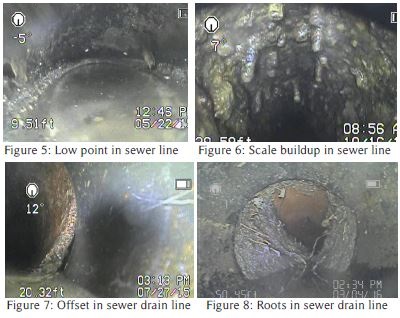
I have had people concerned with how their agents will respond to you finding sewer problems and my answer is that once they understand it, they will accept it. Once the condition is known, the sellers will probably be on the hook and if the buyers back out, they will be required to disclose. In the end the sellers will have to fix it anyway as the likelihood of a homebuyer proceeding with a defective sewer is small. The buyers will be happy and as the saying goes in real estate, a happy wife = a happy Realtor or something like that!
Adding sewer inspections can give your business the opportunity to add more revenue and prepare you for any economic downturn by adding more service opportunities. Inspections give people peace of mind and the sewer inspection is the perfect add-on.
About the Author
Peter Hopkins has operated a successful home inspection company since 1996 and has personally performed over 7,000 property inspections. He is the Co-Founder of United Infrared (UnitedInfrared.com), a national network of contract thermographers which includes training and business coaching in infrared technology and other vision technologies like sewer cameras. He can be reached at peter@unitedinfrared.com or 760-593-2339.
> Free Webinar: Claims and Complaints: How to Stay Out of Trouble
Available Now
Presenter: David Brauner, Senior Insurance Broker OREP
David Brauner, Senior Broker at OREP, shares insights and advice gained over 20+ years of providing E&O insurance for inspectors, showing you how to protect yourself and your business. Watch Now!
(Get a quick E&O/GL quote from OREP in 30 seconds. Premiums begin around $1,000.)



